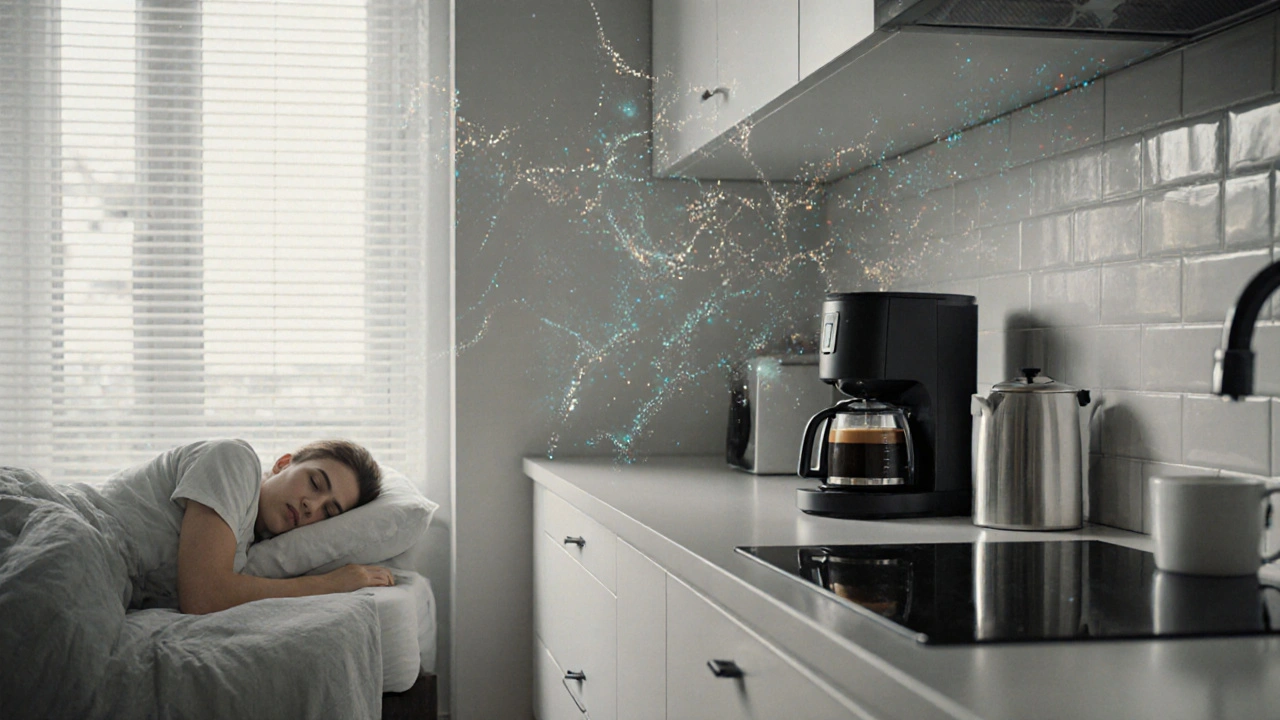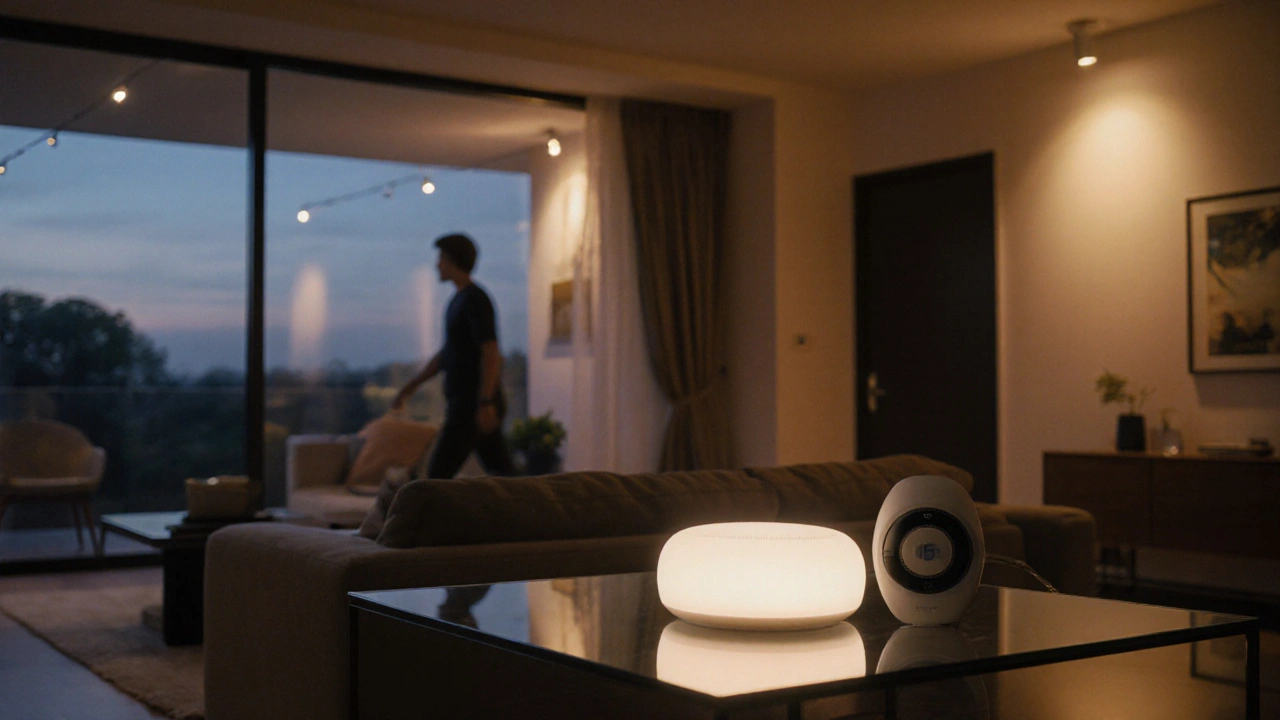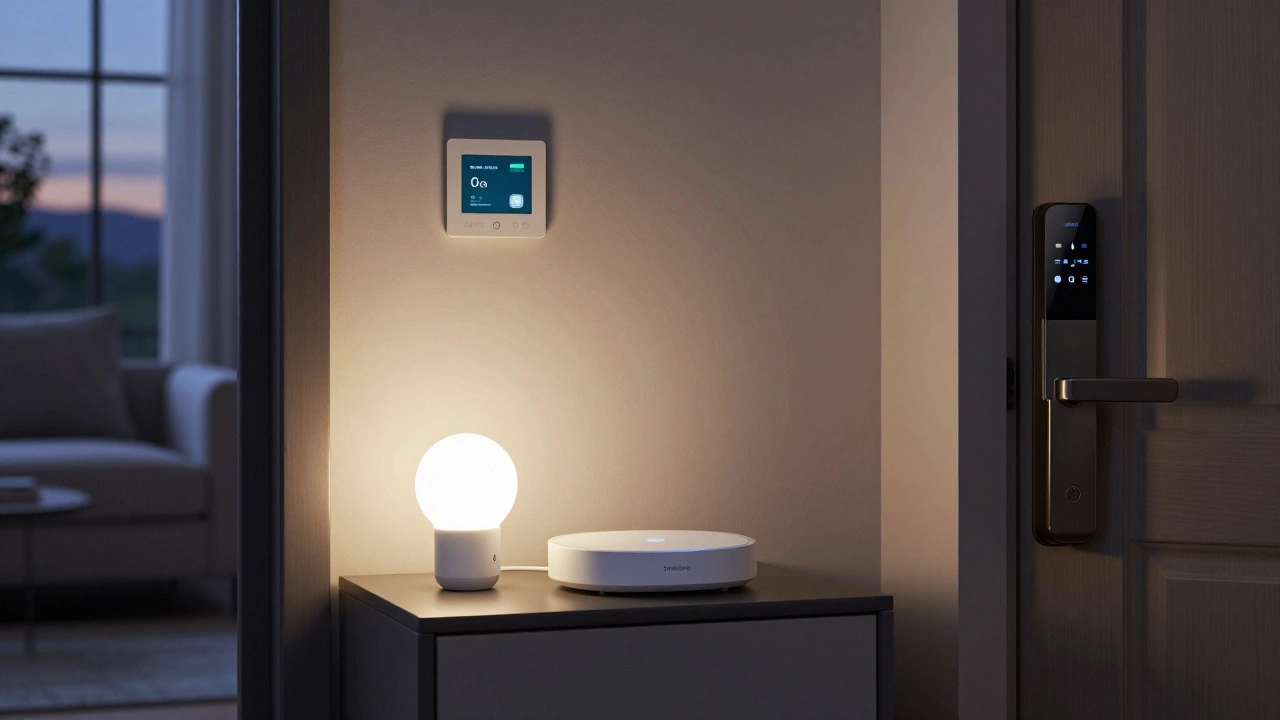A home isn’t smart just because it has a voice assistant or a few connected light bulbs. Too many people think adding a smart thermostat or a Wi-Fi-enabled doorbell makes their house a smart home. But that’s like calling a car electric because it has USB ports. True smart homes do more than connect-they coordinate.
It’s About Integration, Not Just Devices
A smart home isn’t a collection of gadgets. It’s a system where devices talk to each other and respond to your habits, not just your voice commands. If your lights turn on when you walk in but your thermostat doesn’t adjust, your door lock doesn’t sync with your security camera, and your coffee maker doesn’t start when your alarm goes off-you don’t have a smart home. You have a bunch of apps you have to open one after another.Real smart homes use a central hub-like Apple HomeKit, Google Home, or Amazon Alexa-to bring everything under one roof. These hubs don’t just send commands. They learn. They notice that you always dim the lights at 8 p.m. and lower the temperature after midnight. They adapt. That’s the difference between automation and intelligence.
Automation Must Be Context-Aware
Simple timers don’t count. If your lights turn on at 6 p.m. every day, even when you’re on vacation, that’s not smart-that’s annoying. Smart homes use sensors and data to make decisions based on real conditions.For example, a truly smart home knows:
- When you’re home (via phone location or motion sensors)
- When you’re asleep (based on activity patterns and voice commands)
- When windows are open (using temperature and humidity sensors)
- When someone unusual is near the front door (using facial recognition or motion analytics)
These aren’t optional extras. They’re baseline expectations. A 2024 study by the Consumer Technology Association found that 78% of users who upgraded from basic smart devices to full systems reported a noticeable drop in daily stress. Why? Because their home reacted before they had to think about it.
Security Isn’t an Add-On-It’s the Foundation
You can’t call a home smart if it’s vulnerable. A smart lock that can be hacked with a phone app isn’t smart-it’s risky. A camera that streams data to a third-party server without encryption? That’s a liability.True smart homes prioritize security by design. That means:
- End-to-end encryption on all communication between devices
- Local processing for sensitive data (like facial recognition) instead of sending it to the cloud
- Automatic firmware updates without user intervention
- Two-factor authentication for remote access
Brands like Ring, Nest, and Eero now offer hardware with built-in security chips. If your devices don’t have these features, they’re outdated. And if your system relies on a single app that hasn’t been updated in a year, you’re not smart-you’re exposed.

It Must Work Without the Internet
Too many smart homes crash when the Wi-Fi goes down. Lights go dark. Locks won’t open. Thermostats reset to 72°F. That’s not convenience-that’s a failure.A smart home should still function during outages. Local automation rules should run on the hub, not in the cloud. Your lights should still turn on when you enter the room. Your door should still unlock with your fingerprint. Your garage should still close when your car pulls away.
Look for systems that support Zigbee, Z-Wave, or Matter protocols. These are designed to work offline. Wi-Fi-only devices? They’re convenient, but fragile. A smart home that depends on the internet is like a car that won’t start without GPS.
It Learns and Adapts Over Time
The most advanced smart homes don’t just follow orders-they anticipate needs. They notice that you take a shower at 6:30 a.m. on weekdays but sleep in on weekends. They adjust the bathroom temperature accordingly. They see you drink coffee every morning and preheat your mug with the smart kettle. They track how long you spend in the kitchen and suggest meal plans based on your habits.These aren’t gimmicks. They’re powered by machine learning built into the system. Companies like Ecobee and Samsung SmartThings now include AI assistants that analyze usage patterns over weeks, not just minutes. If your system can’t tell the difference between a routine and a one-time event, it’s not learning. It’s just reacting.
Control Should Be Seamless-Not Complicated
You shouldn’t need a manual to turn on the lights. A smart home should offer multiple ways to interact: voice, touch, motion, app, or even gesture. But the key is consistency.Imagine this: You say, “Good night,” and everything shuts off-lights, TV, locks, thermostat, even the coffee maker that was left on. No app tapping. No hunting for switches. One phrase, one action, total control.
If you have to open five different apps to get the same result, you’re not saving time-you’re adding friction. The best systems let you create custom routines with simple drag-and-drop interfaces. No coding. No tech skills needed.

It Should Save You Money and Energy
A smart home that doesn’t cut your utility bills isn’t doing its job. The average smart home reduces energy use by 10-15% annually, according to the U.S. Department of Energy. How?- Thermostats that adjust when no one’s home
- Smart plugs that kill phantom power drain from idle devices
- Lighting that dims or turns off based on natural light levels
- Water sensors that shut off the main valve if a leak is detected
If your smart devices are using more power than the old ones they replaced, you’re losing money. Check your energy usage reports in your app. If you can’t see daily or weekly trends, your system isn’t optimized.
What Doesn’t Qualify
Here’s what you’ll often see marketed as “smart home” but doesn’t qualify:- A single smart speaker with no connected devices
- Light bulbs you control with an app but don’t respond to motion or time of day
- A security camera that only records when you manually start it
- Devices that require separate apps for each brand
- Systems that need constant internet to function
These aren’t smart homes. They’re expensive toys with poor reliability.
The Bottom Line
A smart home isn’t defined by how many gadgets you own. It’s defined by how well they work together, how safely they protect you, and how quietly they make your life easier. It learns your rhythm. It adapts without asking. It keeps you safe-even when you’re not thinking about it.If your home checks these boxes-integration, context-aware automation, security, offline function, learning ability, simple control, and energy savings-then yes, you’ve got a smart home. If not? You’ve got a collection of gadgets waiting to become something more.
Do I need a smart speaker to have a smart home?
No. A smart speaker is just one way to interact with your system. You can control everything through apps, touch panels, motion sensors, or even your phone’s location. Many high-end systems skip voice assistants entirely and rely on automation rules and physical controls. The speaker is optional-it’s not the brain of the system.
Can I build a smart home gradually, or do I need to buy everything at once?
You can absolutely build it over time. Start with one core hub and two or three compatible devices-like a smart thermostat and a door lock. Make sure they support Matter or Zigbee, so they’ll work with future additions. Avoid brands that lock you into their own ecosystem. The goal is to expand, not replace.
Are smart homes expensive to maintain?
Not if you choose wisely. High-quality devices last 5-7 years and often auto-update. The biggest cost isn’t the hardware-it’s buying cheap, incompatible gadgets that break or become obsolete. Stick with trusted brands that offer long-term support. You’ll save more in energy bills than you spend on upgrades.
What’s the most important device to start with?
Start with a smart thermostat. It’s the most reliable way to see immediate savings-most users cut heating and cooling costs by 10-20% in the first year. It also acts as a hub for other devices in many systems. Once you see the benefit, adding lights, locks, or sensors becomes easier.
Do smart homes make my property more valuable?
Yes, but only if the system is well-designed and easy to use. Buyers are increasingly looking for homes with integrated smart features, especially in urban areas. A messy setup with five different apps won’t help. But a clean, reliable system with a single control interface can add 3-5% to resale value, according to a 2025 Zillow report.




Tyler Durden
November 23, 2025 AT 07:36Finally someone gets it! It's not about having a dozen smart bulbs-it's about the damn system working like your brain does. I used to have a Nest, a Philips Hue setup, and a Ring doorbell... all separate apps, all fighting for attention. Then I switched to HomeKit with a HomePod Mini as the hub-and now my house anticipates me. Lights dim at sunset, AC kicks in before I walk in the door, and my coffee starts brewing when my alarm goes off. No voice commands needed. Just... life. Less stress. More chill.
Aafreen Khan
November 24, 2025 AT 16:03lol ugh why are we even talking about this like it's rocket science?? i got a alexa and 3 smart bulbs and i call it a smart home. if u need 17 apps and a phd in iot to turn on a light... u r the problem. also my cat sits on the thermostat and it still works. so yeah. 😎
LeVar Trotter
November 24, 2025 AT 19:28Let’s be real-the industry has weaponized the term 'smart home' to sell overpriced Wi-Fi plugs. True integration? That’s rare. Most systems are siloed ecosystems locked behind proprietary protocols. Matter is the first real step toward interoperability, but even then, manufacturers still bury features behind paywalls. The real win isn’t automation-it’s *predictive* behavior. Systems that learn your rhythm, not just your commands. Ecobee’s AI routines? That’s the gold standard. If your hub can’t tell the difference between a vacation and a nap, it’s not smart-it’s just loud.
Christina Kooiman
November 24, 2025 AT 20:24I’m sorry, but this entire article is riddled with grammatical errors. You say 'a home isn't smart just because it has a voice assistant'-but then you use 'it's' incorrectly in the next sentence. Also, 'they adapt' is not a complete thought-it needs a subject. And you have three separate paragraphs that start with 'A smart home'-that’s repetitive and lazy writing. If you’re going to preach about intelligence in home systems, at least have the intelligence to proofread your own text. Fix the punctuation before you fix the thermostat.
Stephanie Serblowski
November 25, 2025 AT 01:18Okay but can we talk about how the word 'smart' is just marketing fluff now? Like, my toaster doesn't have an app... but it still toasts. Maybe the real 'smart' thing is not needing any of this? 🤔 I mean, I used to have a 'smart' fridge that told me I was out of milk... then it died because the Wi-Fi glitched. Now I just look in the fridge. Same result. Less drama. More peace.
Renea Maxima
November 26, 2025 AT 09:39What if the real 'smart home' is the one that doesn't exist? That you don't need to program, don't need to update, don't need to secure? Maybe the future isn't more tech-it's less. Maybe the most intelligent thing you can do is unplug. Just sit. Breathe. Let the silence be the only algorithm. 🌿
Jeremy Chick
November 27, 2025 AT 07:07Bro. I got a $20 smart plug that turns my lamp on at sunset. I don’t care about your ‘hubs’ or ‘Matter protocols.’ My lights turn on. That’s it. You wanna overcomplicate it? Fine. I’ll just sit here in my dark, unsmart, but perfectly peaceful house. 🤷♂️
Sagar Malik
November 27, 2025 AT 21:23Let me tell you something... this whole smart home movement? It's a surveillance trap. Every device you add is a microphone. Every sensor is a tracker. The 'learning' AI? It's not learning your habits-it's building a behavioral profile for corporate data brokers. And don't even get me started on firmware updates-those are backdoors disguised as 'security patches.' You think you're saving energy? You're just feeding the machine. Wake up. Your house isn't smart. It's a spy.
Seraphina Nero
November 28, 2025 AT 15:09I just wanted to say thank you for writing this. I’ve been trying to explain this to my husband for months-he thinks a smart speaker counts. I told him we need the system to work together, and he laughed. But after reading this, he actually went and bought a HomeKit-compatible thermostat. We’re starting small. But now we’re on the same page. You made me feel less alone.
michael T
November 29, 2025 AT 01:24Y’all are missing the point. The real smart home isn’t about devices-it’s about control. Who owns your data? Who owns your routines? Who owns your silence? If your hub is owned by a tech giant that sells your sleep patterns to advertisers? Then your home isn’t smart-it’s enslaved. I don’t care if your lights sync with your heartbeat. If you’re not running local AI on a Raspberry Pi with a Faraday cage around your router, you’re not living-you’re being monitored. And that’s not progress. That’s surrender.
Megan Ellaby
November 30, 2025 AT 00:52One sentence: Start with a thermostat. It’s the only smart device that pays you back in cash.